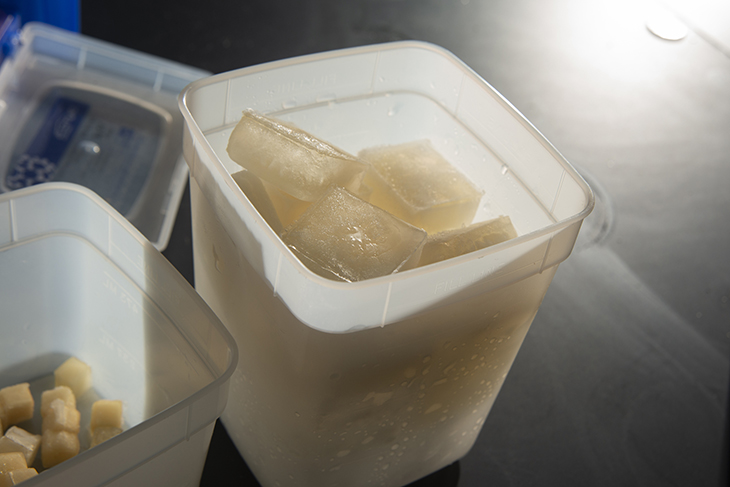
Once again, science prevails as a group of researchers from the University of California, Davis have produced a new type of eco-friendly ice cube. This cooling cube could possible revolutionize the way food is kept cold and kept fresh as it’s shipped all over without having to use traditional cooling packs.
Amazingly, these “jelly ice cubes” are plastic-free and they don’t melt, while also being compostable and anti-microbial while preventing cross-contamination at the same time.
Gang Sun, the professor from the Department of Biological and Agricultural Engineering, shared, “When ice melts, it’s not reusable. We thought we could make a so-called solid ice to serve as a cooling medium and be reusable.”
These jelly-like cooling cubes contain more than 90% water and other components that allow them to retain and stabilize their structures. While they are soft to touch, much like the way a gelatin dessert feels, they also change color depending on their temperature.
According to Ph.D. graduate student Jiahan Zou, who has been working on this project for over two years explains that they are also flexible and reusable, which means they can be designed into any type of shape, as well as cut to any type of size or shape required.
Prof. Sun added, “You can use it for 13 hours for cooling, collect it, rinse it with water and put it in the freezer to freeze again for the next use.”
The research group has already filed for a patent for their jelly cubes last July. What they hope to achieve is to eventually make the cubes using recycled agricultural waste or a byproduct as the coolant material in the future.
Associate professor in the Department of Food Science and Technology, Luxin Wang, said, “We want to make sure this is sustainable.”
How the Idea Came About
The group of researchers began the idea behind their coolant cubes product after Prof. Wang saw how much ice was used in fish-processing plants, noticing that there was cross-contamination that occurred due to meltwater and seeing how this could spread to the other products, as well as go down the drains and contaminate other water sources.
Prof. Wang explained, “The amount of ice used by these fish-processing sites is massive. We need to control the pathogens.”
Moreover, Prof. Sun also shared how more often than not, mold is often found in shipping packages and in the plastic ice packs that are used with school lunches for kids.
Primary tests have also shown how these new types of cubes have the ability to withstand up to 22 pounds without losing their form, while also being able to reuse them over a dozen times or more, all it takes is a quick wash with some water or diluted bleach for reuse. When disposing them, they can be either thrown in the trash or along with the yard waste.
A Great Alternative to Ice
Another positive outcome from these jelly ice cubes is that they offer an eco-friendly alternative to traditional ice, which could possibly lessen water consumption and its adverse effects of the environment. In addition, they provide stable temperatures to reduce possible food spoilage, as well as be a positive for companies during meal prep, for shipping businesses, as well as for food producers that need to keep their food cold.
The eventual application of these jelly cubes could potentially lessen water consumption in the food supply change, as well as reduce food waste by being able to control microbial contaminations.
You can see the research study here, which was published in the American Chemical Society’s Journal, Sustainable Chemistry & Engineering.
If you’d like to hear more about these eco-friendly, sustainable “ice” jelly cubes, watch the video below.
What are your thoughts? Please comment below and share this news!
True Activist / Report a typo


